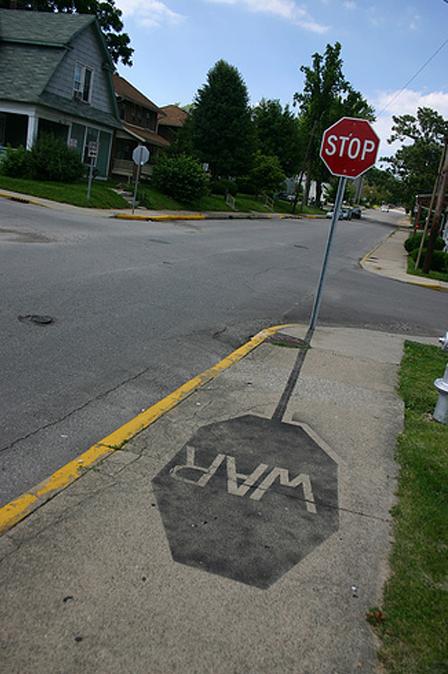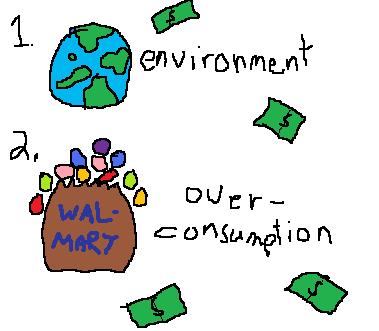What’s up mass comm. class? I know we all have the same feeling right now. Yahoo! This is the last academic blog I will have to write… well for this semester anyhow. But do you know what I JUST realized as I was about to get into my “Activist Project” blog disccussion? I have come full circle in this class. My media autobiography at the beginning of the semester was a “magazine” revolving around the daily damage we do to the environment. Driving to school and using plastic coffee cups were both discussed in my 1 minute presentation to all you bloggers. I have done a lot of reading, a semiotics paper, and 12 blogs inbetween, all leading right back to the environment.
Remember how people used to believe that the earth was the centre of the universe (geocentrism), well they were somewhat correct. Instead, I think it should be called “kosmoscentric” the word “kosmo” in Greek, meaning “people”. It seems like this world revolves around the interest of humans, and our short-term selfish wants.
Mr. George Stroumboulopoulos, past graduate of Humber College, has his own little activist project going on right now. We have always heard that one small act makes a difference, and George is challenging us Canadians. He wants everyone to participate in One Million Acts of Green. What is an act of green you ask? Well, it “is an opportunity to help the environment” by “reducing your greenhouse gas emissions.”[1] People who claim they don’t care about the environment are:
a. selfish (of other people’s future)
b. scared (of what might happen, so they choose to ignore)
c. uninformed (honestly don’t know the seriousness)
d. all of the above
If you don’t understand George’s message from me telling you, listen to him yourself! J
[2]
As you saw in the video, there were a good amount of little green dots with different pictures in each, kind of looking like this:
Each picture represents a different act that you can do. Let’s go through these eight examples together:
(1) Air-dry clothes
(2) Carpool
(3) Caulk drafty areas
(4) Check your tire inflation
(5) Clean or replace your furnace filter every season
(6) Clean the fridge coils once a year
(7) Do laundry in cold water
(8) Don’t idle
What do you think the two things I always have in my car are? No, not my sunglasses or my Highschool Musical 3 CD. It’s post-it notes and a pen. Sure, they come in handy if someone cuts me off and I have to get down their plate, but I use it so that I can write notes and stick them on other cars. If someone runs inside and leaves their car idling, I’ll write a kind note along the lines of, “You’re idling car in the middle of the parking lot is killing the environment… not to mention blocking traffic. Please refrain from doing this again. Have a fabulous day. J” I love it too when I happen to catch their reaction after reading the note. It’s usually a “how dare someone do this?” pissed off kind of look. A bit of a hypocritical move on their side I say.
People are getting frustrated by petty “environmental laws” that are being passed, which take 5 years to even be considered at in the first place. I couldn’t have said it better myself, so I didn’t: “Now that we’ve re-appointed a government whose policies represent a significant threat to environmental issues, our individual efforts are even more crucial in making our community a little – or a lot – greener.”[3]
Noam Chomsky reminds us that “If our minds were blank slates… we would be very impoverished indeed.”[4] Activist groups are very important because they bring emotions from the heart, and introduce them to other people’s heads. They are able to move away from the mainstream focus of culture, and look at the picture as a whole. I am looking at my surroundings right now and see my laptop, TV, and light all on. I am blogging at 1:44am. Do I really need to be wasting that much electricity? I think not! I am taking part in George’s OMAOG right now. I am going to turn off my light and shut off my TV. Ready? ……I’m standing up………I’m going now………………DONE! I did my part. Now do yours too! Peace out bloggers. Stay smart, cause I know y’all are! J
[1] One Million Acts of Green. CBC. 26 Nov. 2008 <http://green.cbc.ca/whatisaog.aspx>.
[2] One Million Acts of Green – George. 29 Oct. 2008. YouTube. 26 Nov. 2008 <http://www.youtube.com/watch?v=cv9qv0qhpjo>.
[3] The Hour’s One Million Acts of Green. 20 Oct. 2008. BlogTO. 26 Nov. 2008 <http://www.blogto.com/environment/2008/10/the_hours_one_million_acts_of_green/>.
[4] Manufacturing Consent. Perf. Noam Chomsky. 1992.














